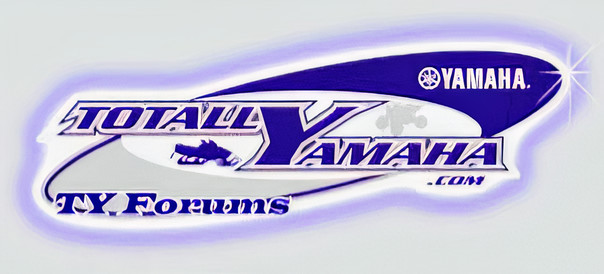supercharged111
Member
Unless you have a very strong press a hammer is usually the tool of choice for this...old school riveting...buck and rivet. We used a bucking bar and hammer type air riveter on Float plane float repairs back in the day...and that is probably still the technique.
It's a 20 ton, I mashed them down some more.
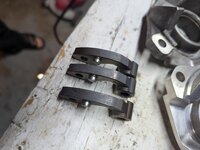
But I also read on here someone cranked them down until they crumbled and I didn't want that either. I could take them down further, but they're aluminum.
Dry fit install them in the clutch without the spring and cover and ensure they move freely and their side clearance is such that they have no chance of contacting anything and if they have plenty of clearance you are good to go.
supercharged111
Member
They passed that check, I got the other 148.3 jets in all 3 carbs, stock 45 degree helix back in, and wound up to 70 degrees per SLP's instructions. Went for a quick rip and it seemed at first like it was going to be very close at WOT, tach seemed to be in that 8700-8800 range when I'd crack on it. Then as it warmed up more it seemed to get worse. It would try to go, but lug down whereas before it wasn't lugging down. That doesn't sound like clutching to me. I had maybe 5 miles on the sled with new BR9ES plugs and the center looked a nice dark brown but the outers looked lean. Maybe I needed more time on the plugs? Hard to say, it was probably 50 degrees out so less than ideal testing conditions but the thing should have been pig rich and definitely wasn't. Before I left the garage the response off idle felt off. Oh well, maybe it's a bit loaded up? Who knows. After I spun the plugs back in, I tried snapping the throttle to WOT instead of working up to it like usual. I was met with a distinct bog. So I gave it half a choke and tried and the thing just jumped. So I'll yank the carbs tomorrow, back the fuel screws out 1/4 turn (probably won't be enough), and repeat. And get some bigger pilot jets coming sooner than later. Is there another jet I'm not tracking that I may need to screw with? I know if those fuel screws don't want to be close to 1.5 turns out that the whatever jet is too small, is that the pilot or something else I should be aware of?
Edit: per the Hammer carb tuning article, the only jets affiliated with that screw are an air jet or the pilot jets which I was planning on going up with anyway. I'd had it in my mind that pilots were mid-range more so than low end but it seems that's not the case. Needle height for the midrange and if that's off I need a different needle or nozzle which can't be had anymore.
Edit: per the Hammer carb tuning article, the only jets affiliated with that screw are an air jet or the pilot jets which I was planning on going up with anyway. I'd had it in my mind that pilots were mid-range more so than low end but it seems that's not the case. Needle height for the midrange and if that's off I need a different needle or nozzle which can't be had anymore.
Last edited:
supercharged111
Member
I'm having a hard time finding part numbers for 47.5 pilot jets and 150 main jets on Partzilla.
They do list the 50 pilots, and I found some 150 mains in a google search listed under the 600 but for the Phazer?
 www.partzilla.com
www.partzilla.com
While I should be able to ride as late as April, it's getting less convenient as the weather heats up.
Edit: Looks like they make it easy with the pilots as the size is in the part number.
 www.partzilla.com
www.partzilla.com
Can someone confirm those mains are correct? If so I'll get those, 47.5, and 50 pilot jets on the way. Thinking back, the sled was asking for a little more even single piped. I ran my friend on his 800 Storm and when I snapped the throttle from a dig it had a bog. That was the only time I'd done that this year. Response off idle is worse now, so wouldn't surprise me if I end up on the 50 pilot when it's all said and done.
They do list the 50 pilots, and I found some 150 mains in a google search listed under the 600 but for the Phazer?
YAMAHA OEM MAIN JET - 3G2-14231-30-A0 | Partzilla.com
Buy YAMAHA OEM MAIN JET - 3G2-14231-30-A0 ✓ FREE Shipping on qualified orders - Partzilla.com
 www.partzilla.com
www.partzilla.com
While I should be able to ride as late as April, it's getting less convenient as the weather heats up.
Edit: Looks like they make it easy with the pilots as the size is in the part number.
YAMAHA OEM PILOT JET - 3H1-14142-47-00 | Partzilla.com
Buy YAMAHA OEM PILOT JET - 3H1-14142-47-00 ✓ FREE Shipping on qualified orders - Partzilla.com
 www.partzilla.com
www.partzilla.com
Can someone confirm those mains are correct? If so I'll get those, 47.5, and 50 pilot jets on the way. Thinking back, the sled was asking for a little more even single piped. I ran my friend on his 800 Storm and when I snapped the throttle from a dig it had a bog. That was the only time I'd done that this year. Response off idle is worse now, so wouldn't surprise me if I end up on the 50 pilot when it's all said and done.
Last edited:
2001 SRX used a 150 main jet in the PTO side 3G2-14231-30-A0
1995-1997 Vmax 4 used 47.5 pilot jets 3H1-14142-47-00
Parzilla has all in stock
1995-1997 Vmax 4 used 47.5 pilot jets 3H1-14142-47-00
Parzilla has all in stock
supercharged111
Member
Thanks for confirming that, had all that in the cart and now it's on the way! In the meantime I'll turn that fuel screw out and see where that gets me.
Our Bender piped 700s needed 52.5 pilots stock ports....55.0 ported
supercharged111
Member
Holy crap. Was that to get good off idle throttle response at the factory 1.5 turns out?
Yes and that is basically what Bender recommended in their install instructions....different pipes then you though so just info...Holy crap. Was that to get good off idle throttle response at the factory 1.5 turns out?
supercharged111
Member
Sled responded favorably to 1.75 turns out. It may want a smidge more, but the improvement was instantly noticeable. Now I'm extremely conflated: is my problem fueling or clutching?
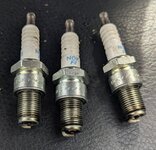
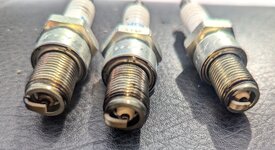
Left to right is mag, ctr, PTO. Those outers, esp PTO, look lean. This was me hitting the kill switch at WOT. When you get into it, it zings up around 8800 or so right where it needs to be and about as soon as it gets there lugs down to 8100. Obviously it doesn't sound as healthy as 8100, so I don't know if it's that or the engine is truly unhappy. If anything, compared to the last time I rode it it should be better in terms of carburetion as all 3 mains are 148.3 and the fuel screws are out 1/4 turn more. Small potatoes I know, but it's not leaner. Current temp is 32* F. I'm scared to try and dial in the clutching with it this way unless I'm misunderstanding something with plug reading. It should need any real time to build up on the plug, right? I tried this at mid throttle too and they looked better there but I didn't bother with a pic.


Left to right is mag, ctr, PTO. Those outers, esp PTO, look lean. This was me hitting the kill switch at WOT. When you get into it, it zings up around 8800 or so right where it needs to be and about as soon as it gets there lugs down to 8100. Obviously it doesn't sound as healthy as 8100, so I don't know if it's that or the engine is truly unhappy. If anything, compared to the last time I rode it it should be better in terms of carburetion as all 3 mains are 148.3 and the fuel screws are out 1/4 turn more. Small potatoes I know, but it's not leaner. Current temp is 32* F. I'm scared to try and dial in the clutching with it this way unless I'm misunderstanding something with plug reading. It should need any real time to build up on the plug, right? I tried this at mid throttle too and they looked better there but I didn't bother with a pic.
supercharged111
Member
Said screw it tossed on the RX1 helix and went for a rip. Totally different machine. Would hang around 8500 or so up until 80 then the needle wanted to go past 9000 and I had to shut it down. Back in went that Bender helix. From a dig with both the RX1 and Bender helixes the thing would only tach out around 8000. If you lifted and got back in it, the Bender would tach out around 8600 and hold. I'm hoping those larger pilot jets will correct the off the line RPM issue. If you just roll into it like normal it doesn't do the 8000 RPM thing at all. Sled is otherwise good and snappy. I kinda wonder what stock weights with the RX1 helix would do, maybe I'll try that next. For now I'm trying to find some primary shims to cheat my way to 8800 with the existing setup. What's wild is the extent to which that Bender helix corrected the shift RPM being inconsistent. Even on stock clutching with the single pipe, I hadn't run the stock helix in so long I'd forgotten what the Bender piece fixed.
supercharged111
Member
This looks like what Hammer calls out in his tuning writeup.
I think those plugs on the vid have been around for a while.
I went and watched a number of Youtube videos and it turns out the rich/lean condition is shown on the porcelain. Without cutting a plug apart you can't see it with a ton of detail, but I should have been looking DEEP down inside the porcelain instead of staring at the ground straps like I have been.
Last edited:
supercharged111
Member
Today was a massive disappointment. I popped in the 47.5 pilots in exchange for the stock 45s and set them back at 1.5 turns out (previously had stockers at 1.75 turns out). Installed a single engagement shim, went for a ride. Sled is back to an inconsistent shift RPM just like it was on the stock helix. Unbelievable. How am I supposed to make meaningful progress if the sled won't act the same from one day to the next? I get that warmer temperatures will make it run a little different, but going from holding a consistent steady RPM at WOT to not? I don't even know what to do now. Last time I rode it it WOT shifted at 8600 all the way up to 100 on the lie-o-meter. Today it backshifted to about 8700-8800 and as soon as it hit that RPM lugged down below 8500 and stayed there and was not happy. I want to go back tomorrow, but really don't feel like I can make anything productive happen.
supercharged111
Member
Went out again today and finished swapping out a trailing arm. Then put the stock weights back in. I don't ever recall the RPM swing being a thing with the stock 8CH as it was with the 8CR. Went for a ride and shift RPM was too low. Put in a 2nd engagement shim and no change there. Said what the hell and popped in the RX1 helix. That one kept it lugged down around 8200 the whole time. It has more RPM when it's kinda piss warm the first time or 3 you crack on it, then once it's got a little more heat in it the RPM is lower. That much has been consistent since I installed the pipes and began watching the tach like a hawk. What's blowing me away here is that, compared to when I was a single pipe, I now have 2 engagement shims and at one point had the same helix with an extra 10 degrees but a lower shift RPM?! Makes absolutely no sense to me. After today's failed experiments I came home and drilled the rivets out of the 8CR and pulled out the pink secondary spring I had in the basement, that one's stiffer than the green stocker in there now. I want to order up a y-s-y primary spring as that one has a higher rate with the same preload, so presumably the only change that ought to make is to bump the shift RPM up globally which is what I was hoping to achieve with the shims. But maybe the pipes make less torque than the stock setup and the stiffer secondary spring will help with backshifting? One thing that's becoming quite clear is that there is no such thing as too many weights, springs, rivets, etc. One last question: is there such a thing as too much preload? Does one get to a point with preload where they should be thinking more about a spring change?
supercharged111
Member
Tried the drilled out 8CR weights, left the engagement shims in, Bender 49/45 helix at 70 degrees, and tried it out. It wanted to rev its face off, right past 9000 no questions asked. Came back and pulled the shims, went back out. Same deal. Pulled over on the trail and backed the helix down to 60 degrees, took off, and it was an absolute turd. Pulled back off the trail, turned it back up to 70, less of a turd but not over-revving like it was 5 minutes ago at 70 degrees. I rode it some more like this to try and better characterize it as the trail flows differently depending on which way you're going. At about 60mph the RPMs dump. Lay into it from say 30 and it shoots right up to 9000, holds, and predictably dumps down to 8500. Try a backshift at 60 and it'll be fine to tach up nicely then back down to 8500 which is a total buzzkill compared to 9000. Only thing I changed on this particular trip was starting with the helix at 70 and over-revving, changing to 60 and it being a turd, back to 70 but now not over-revving. Seems to me something was sticking at the start of the trip and loosened up by me monkeying with the secondary. The secondary sheaves seem to have quite a bit of slop in them so I'll need to get a bushing ordered. My Bender helix is also a bit sloppy compared to the 2 Yamaha units. How big a deal is that seeing how it's secured to the secondary sheave? I need to get some 8DN weights on their way to try and straighten this curve out. It's probably worth trying that RX1 helix again tomorrow too.
supercharged111
Member
How are the 8DF weights? They look to have a VERY steady curve. Plus I see that's what the redheads went to in 2000.
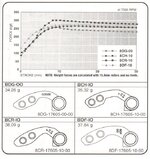
Compared to the 8DN-10 which looks like it'd kick the engine in the nuts in the midrange?
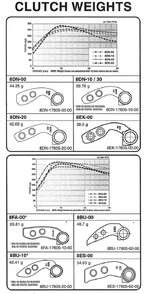
8DN-20 would hit even harder. How should a guy think of the stroke in terms of speed? I can get my hands on 8DN-10 and 8DF for a reasonable price compared to new. Not seeing any 8DN-20 secondhand at the moment. We're getting to the point that shipping eats up precious remaining days with white trails. I ordered a bunch of crap last night, to include but not limited to 2 secondary bushings. One for the sheave and the helix takes the same one, hopefully the Bender can take a Yamaha bushing. I'll need to measure to see. They definitely used a different bushing material. I have new plastic slider dealies on hand to install as well to get the secondary as fresh as I can. There's not but a few hundred miles on that primary sheave bushing, but I'll pay more attention to it the next time I have that out of the sled as well.

Compared to the 8DN-10 which looks like it'd kick the engine in the nuts in the midrange?

8DN-20 would hit even harder. How should a guy think of the stroke in terms of speed? I can get my hands on 8DN-10 and 8DF for a reasonable price compared to new. Not seeing any 8DN-20 secondhand at the moment. We're getting to the point that shipping eats up precious remaining days with white trails. I ordered a bunch of crap last night, to include but not limited to 2 secondary bushings. One for the sheave and the helix takes the same one, hopefully the Bender can take a Yamaha bushing. I'll need to measure to see. They definitely used a different bushing material. I have new plastic slider dealies on hand to install as well to get the secondary as fresh as I can. There's not but a few hundred miles on that primary sheave bushing, but I'll pay more attention to it the next time I have that out of the sled as well.
When the secondary bushing is worn it will cause random binding, poor backshift and inconsistent clutching. Once you have the secondary clutch refreshed you will find it far easier to dial in.
One thing to remember when thinking of using 8DN weights is that they were for use on the SRX 700s that had power valves so the engine typically had more mid range torque that the red heads are lacking with fixed exhaust ports.
I had excellent luck using heavy hitters on our piped SXs
supercharged111
Member
When the secondary bushing is worn it will cause random binding, poor backshift and inconsistent clutching. Once you have the secondary clutch refreshed you will find it far easier to dial in.
What's wild is the sled did NONE of this before the pipes. No use in overthinking at this point as the sheave is sloppy and the sled is just over 5000 miles so this is to be expected. Rollers look good and I scrubbed the clutches extensively with a toothbrush and krud kutter at some point with the pipe install.
One thing to remember when thinking of using 8DN weights is that they were for use on the SRX 700s that had power valves so the engine typically had more mid range torque that the red heads are lacking with fixed exhaust ports.
I imagine the triple pipes exacerbate that lack of midrange torque on a redhead? Would that build a case for the 8DF weights? Do you have any experience with them? Looks like the SRX600 and SXR used those weights. And they used a long cover which looks tempting as I can get springs with higher preload but with the same rate. Crazy how much you miss on your first read through the tech section.
I had excellent luck using heavy hitters on our piped SXs
I've no idea what those are, are they still available and easily adjustable? I'm thinking of trying screws and washers from the hardware store instead of rivets, much quicker and easier to make changes that way.
